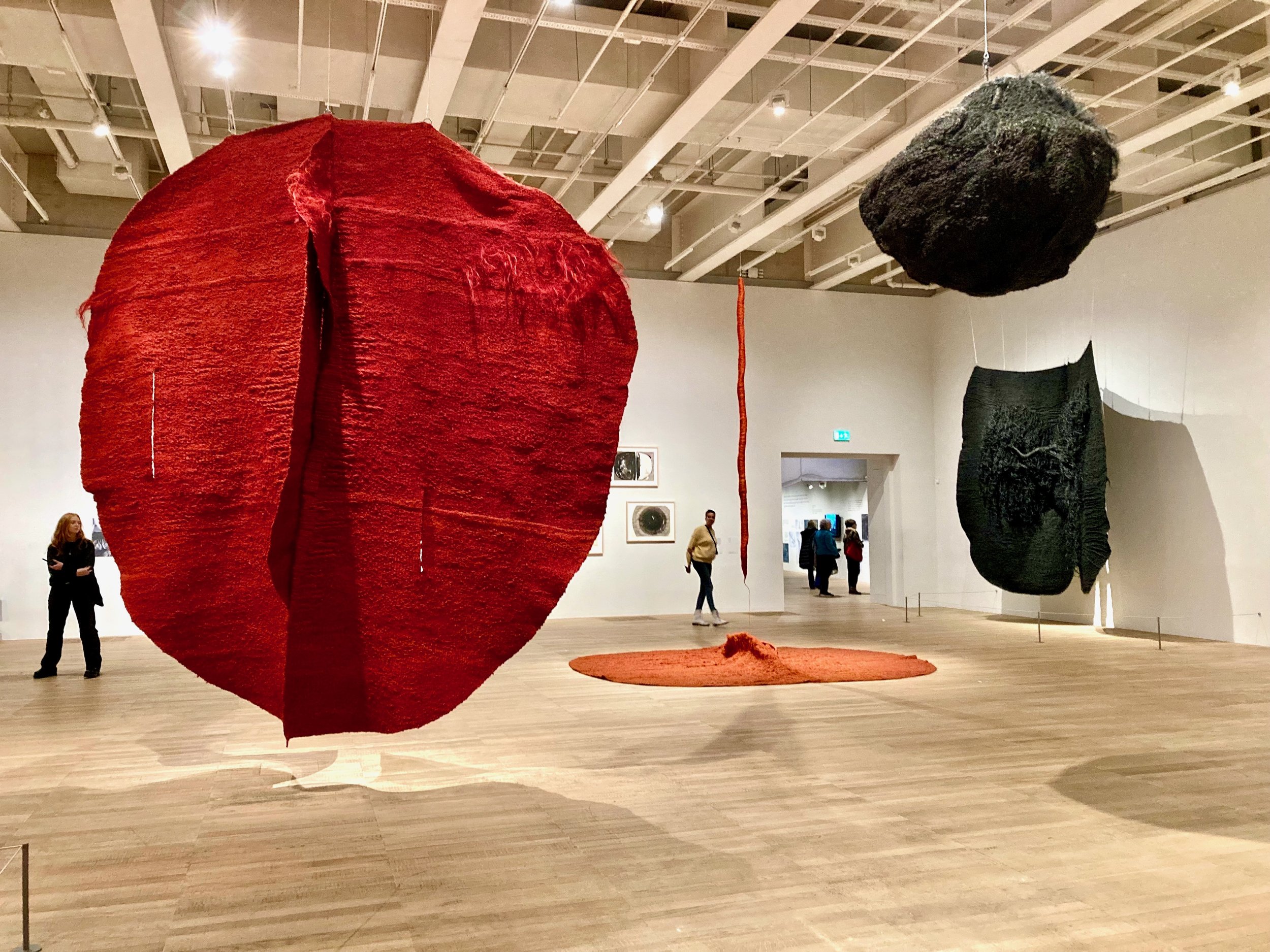I was once a ballet dancer. In fact, dance of all forms – ballet, Highland, tap, disco and soul – was an important part of my identity, so much so, that one would have expected my practice to have been centred on performance until only a few years ago when arthritis, lipoedema, Covid and knees with a tendency to dislocate combined to curtail that part of my life.
My performances are no longer centred on dance, thanks to arthritis: this act was a mime undertaken as part of an intervention with another student’s work. Photo Lloyd Darling Good
Life can be tough, but that is the way it is and there is nothing I can do about any of the above except get on with life. However, what do I do about the latent energy and desire to move wildly that still bubbles within? As an artist, it is all very well and pleasant to sit sketching, painting, origami and so on, but what really fires me up is when I get physical with the material and then start picking away at its materiality and its relationship with the space it is in, its relationship with me and its relationship with the viewer.
In manipulating cardboard I used both physical and mental energies: stretching and walking around it in order to cut through the substrate, join pieces together and affix them to the surfaces available, all the while thinking, thinking, thinking: “What if I do this? Look what happened when I cut this way instead of that way. What is it doing to this space? Why won’t it fit? Why isn’t it doing what I thought it would?” The last two questions can come from frustration and impatience, which of course is not good. When this happens one needs to stop, and think critically. For example, cutting through the cardboard was hard on my hands, making them stiff and painful. I knew I had arthritis, so why didn’t I stop and develop another method sooner rather than later? Why didn’t I use tools to help with the cutting? The problems were also compounded by the mental impact of having struggled with the cardboard and then for all my work to come to nothing thanks to the way the decorators mishandled my work at the start of the year: I was physically and mentally broken, and that whole period sickened me so much that I felt unable to carry on with the project.
Magdalena Abakanowicz’s monumental hanging tapestries at Tate Modern. Photo Shirley A
I wasn’t convinced that I could turn any of this into a positive. But, incredibly, it has happened in a short space of time. Instead of simply giving up, I kept interested in art with activities that have nothing to do with my project (but of course everything has an influence on one’s practice): I went to see shows such as Magdalena Abakanowicz, Maria Bartuszová and Yayoi Kusama at Tate Modern, Carol Schneeman at the Barbican, Lynette Yiadom-Boakye at Tate B, Peter Doig at the Courtauld – and I returned to the cinema, where I became mesmerised by the funny and moving Broker and the hauntingly desperate Gotland.
It was with Abakanowicz’s monumental hanging sculptures that I saw strong links with my work. A member of the fibre art movement, she saw the material, “as the basic element constructing the organic world… the tissue of plants, leaves and ourselves”1. This is how I view paper - it comes from trees and by manipulating them into tree-like sculptures, I bring nature into my work. And the cycle perpetuates: when viewers see my work, they recognise - consciously or subconsciously - the forms and so nature is absorbed back into their psyche.
Turning points
Visiting lecturers Julie Hill, Karen David and Florence Peake also worked their magic, so that slowly I was drawn back into the project with different perspectives: Julie with her crumpled paper sculpture Dark River that got me thinking about the materiality of paper and how working with that would be kinder to my body than cardboard; Karen with a fictioning workshop, where I reassessed whether my installation should be based on an overgrown secret garden or one that is more abstract, more zen; and Florence who, through communicating with her entire body, made me realise that, despite my infirmities, my body was still physically relevant to my practice, that it could still have a positive impact on how I work.
Turning frustration into art: Manuel Solano’s Giving the Finger shown at DCA 2022. Photo Shirley A
Giving up? No way
In fact, Manuel Solano – whose practice is similar to mine being based on childhood moments affected by family, friends, TV, film and pop music – completely transformed their way of working when they lost their eyesight in 2014. Since then, Solano has reconfigured their practice and created a body of work in painting, sculpture and film using tactile mapping techniques with pins, string and pipe cleaners to form shapes that they can feel with their hands. Their Giving the Finger reflected the anger they felt at having lost their sight: “I wanted to give the finger to everybody who would look at this painting, just because they could look at it.”2
While I’ve never felt that I need to give the finger to anyone regarding my health, I admire Solano’s tenacity in continuing their practice, particularly painting, which many would have expected them to give up. I’ve got to do what I need to do, otherwise, what am I?
Laura Cummings, ‘Magdalena Abakanowicz: Every Tangle of Thread and Rope Review - A Wonder Weaver’, The Guardian, 20 November 2022, <https://www.theguardian.com/artanddesign/2022/nov/20/magdalena-abakanowicz-tate-modern-london-review-every-tangle-of-thread-and-rope> accessed 20 April 2023.
Manuel Solano, The Top of Each Ripple, Dundee Contemporary Arts, 27 August-20 November 2022.


